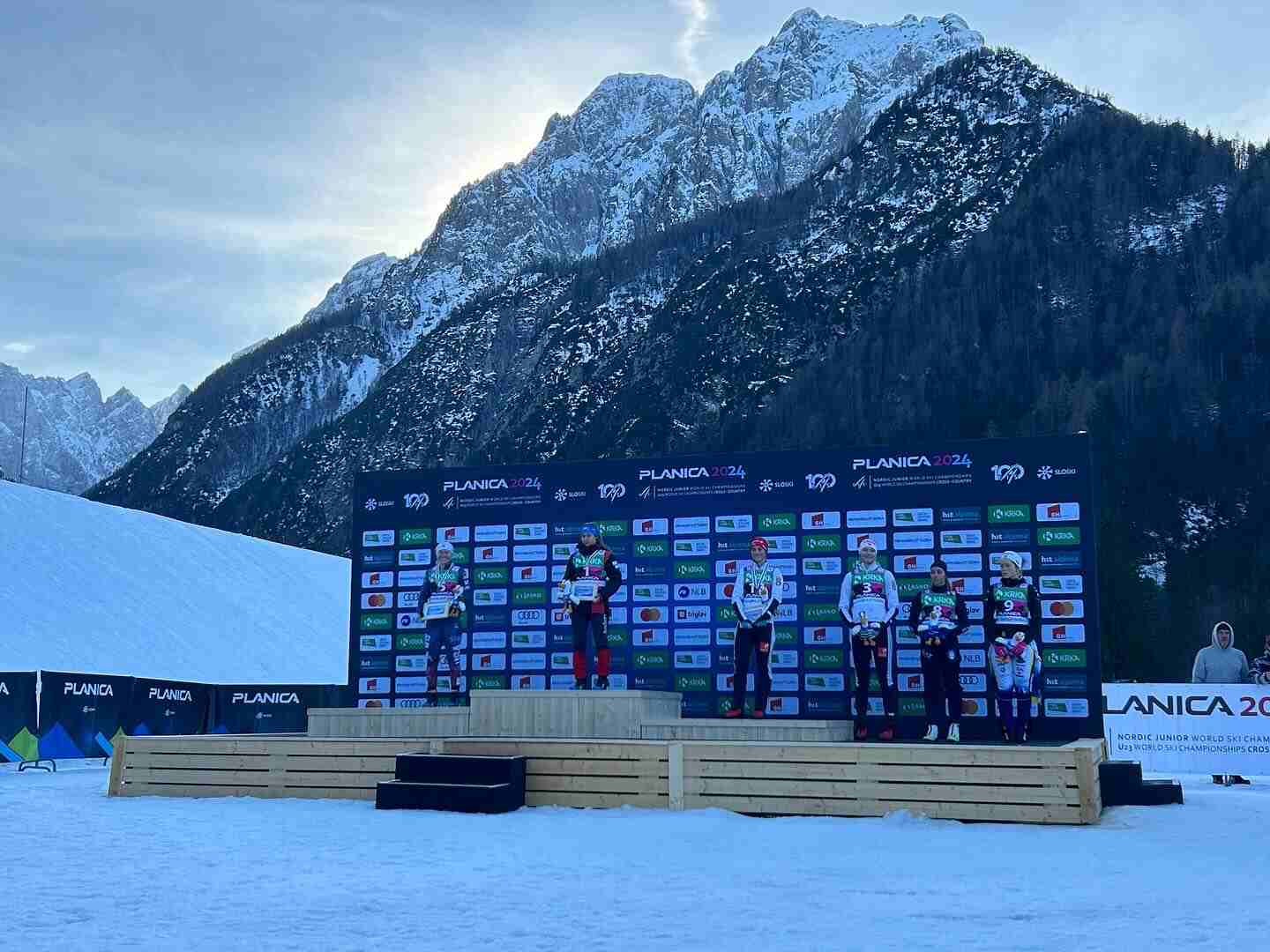
Planica, Slovenia occupies a pretty unique corner of the world, with special emphasis on the “pretty.” Miss a turn in the traffic circle outside the venue, and in five minutes you’ll find yourself at the Austrian border. Miss the next turn, and you’ll find yourself at the Italian border. The valley in the Julian Alps is defined by a kind of beautiful thought—go over the mountains on any side and you find yourself in a different world. This is where Romantic, Germanic, and Slavic Europe met. And within these towering limestone walls there’s an all encompassing, separate, and singular focus: nordic skiing.
Planica seemed to revel in its recent role as the place the entire ski world met this past week. After hosting the 2023 World Nordic Ski Championships, 2024 brought the Junior and U23 event of the same scale.
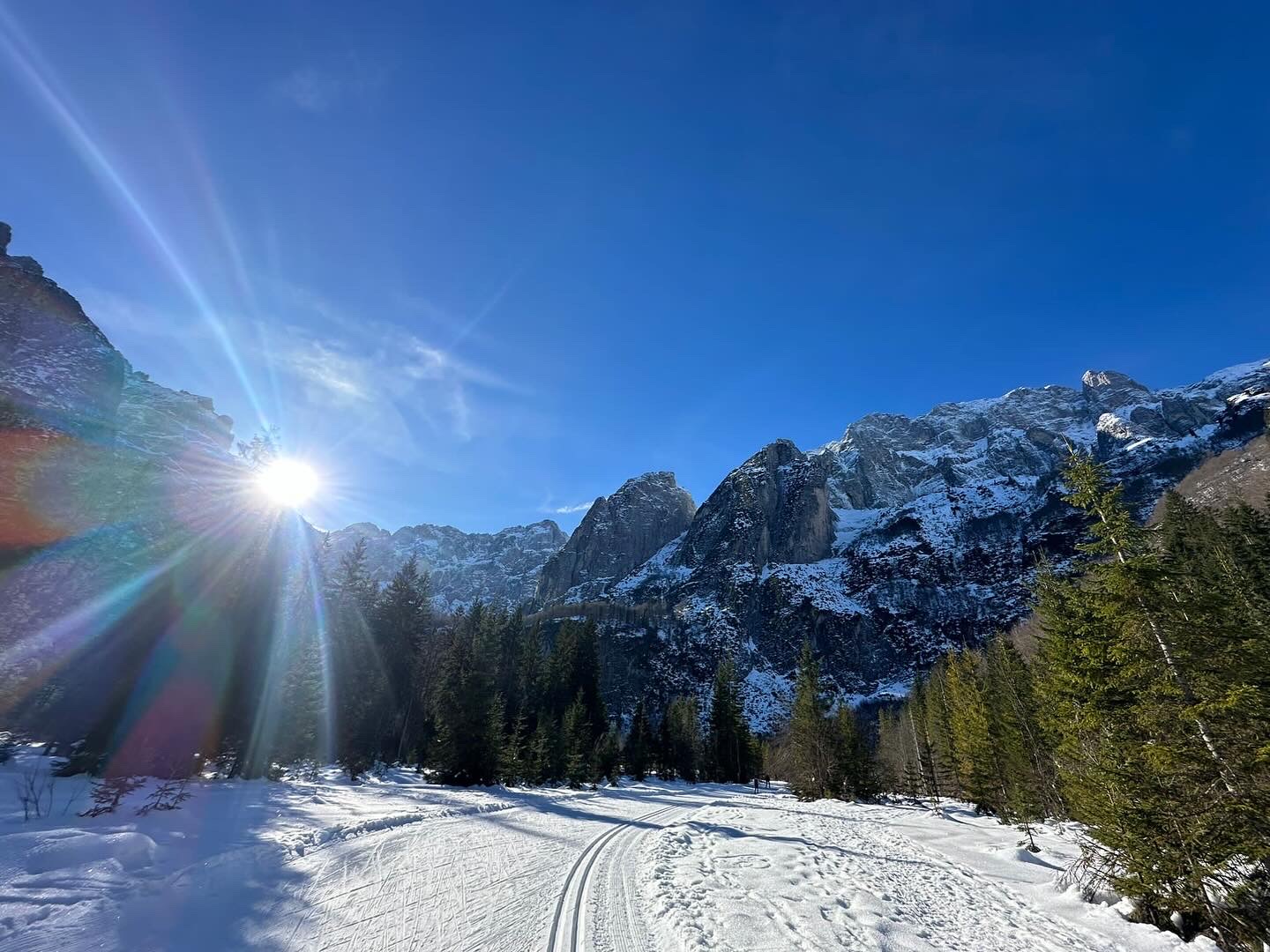
For the US Ski Team, “World Juniors” has played prelude to the country’s ascent through the ski world ranks. A generation ago, it was the first stage where American skiers Kris Freeman, Andy Newell, and Kikkan Randall popped onto international podiums. Those athletes went on to redefine what was possible for American skiers. Since then, Jessie Diggins, Ben Ogden, Gus Schumacher, and notably, the all-around depth-requiring Relay teams have had success at the event. In 2024, that perspective was especially pertinent for Team USA. Junior World Championships is always a nexus point in a skiers career; for Americans this season, it just so happened to be a crux for the sport itself, and its transformation over a generation in the United States.
The occasion also provided a reference point on how the United States has evolved and now operates when it comes to competing on an international stage. There, perhaps, the most notable thing is that the United States has a notable presence. This year’s delegation of skiers, coaches, and service team totaled nearly 40 people, with roles ranging from Relay Anchor to Head of Kick Wax to Passport Collector to Snack Finder all having to work in concert to make for competitive skis, and competitive skiers. Tucked in among the Norway and Sweden wax trucks were four wax cabins marked “United States of America.” Throughout the week, techs, coaches, and athletes from across the world stopped in to remark that the United States is having a season of success like no other. From Jessie Diggins shout-outs to uniform exchange requests á la an international World Cup soccer match, skiing in America was on the skiing world’s mind.
Still, for all the ways the United States now looks like a bonafide skiing nation on the international stage, there are still ways it differs, too. The US wax cabins are still the only ones you’ll walk by and hear country music blaring from. The wax technicians returning from wax testing all invariably started their recovery with a Coca-Cola. When not clad in US Ski Team gear, the American athletes were all showing their school pride from the college teams that uniquely play a critical role in incubating talent in North America, and as conditions changed throughout the week, all pined for locales across the North American continent that Planica reminded them of in that instance. In the dry, sunny slush of the early week, it was Lake Tahoe, California or Soldier Hollow, Utah, before a solid three days of rain elicited a comment from one US athlete that, “I came halfway across the world to ski like I’m back in Craftsbury, Vermont.”

That wide range of locales still defines American skiing when it travels abroad. The process of getting the best U23 and Junior skiers in the country all to one place happens as a slow amalgamation by parts, rather than in one wave. This year, there were skiers who joined up to two weeks before Championships for a pre-camp in Toblach, while others came from a World Cup in Switzerland. Still more came from racing domestically days before starting to race in Slovenia. Eventually, they all camped out across the Slovenian border in Italy, crossing the international border daily (and making quick friends with Italian border guards in the process). And so, half a world away, a tight knit group of the nation’s best athletes was together, and stayed that way throughout the week. By the time that many are at World Juniors, they’ve already skied with each other for years, forged bonds through other NNF and US Ski and Snowboard projects such as the National Elite Group. By the time they arrived in Planica, they operated as a cohesive unit.
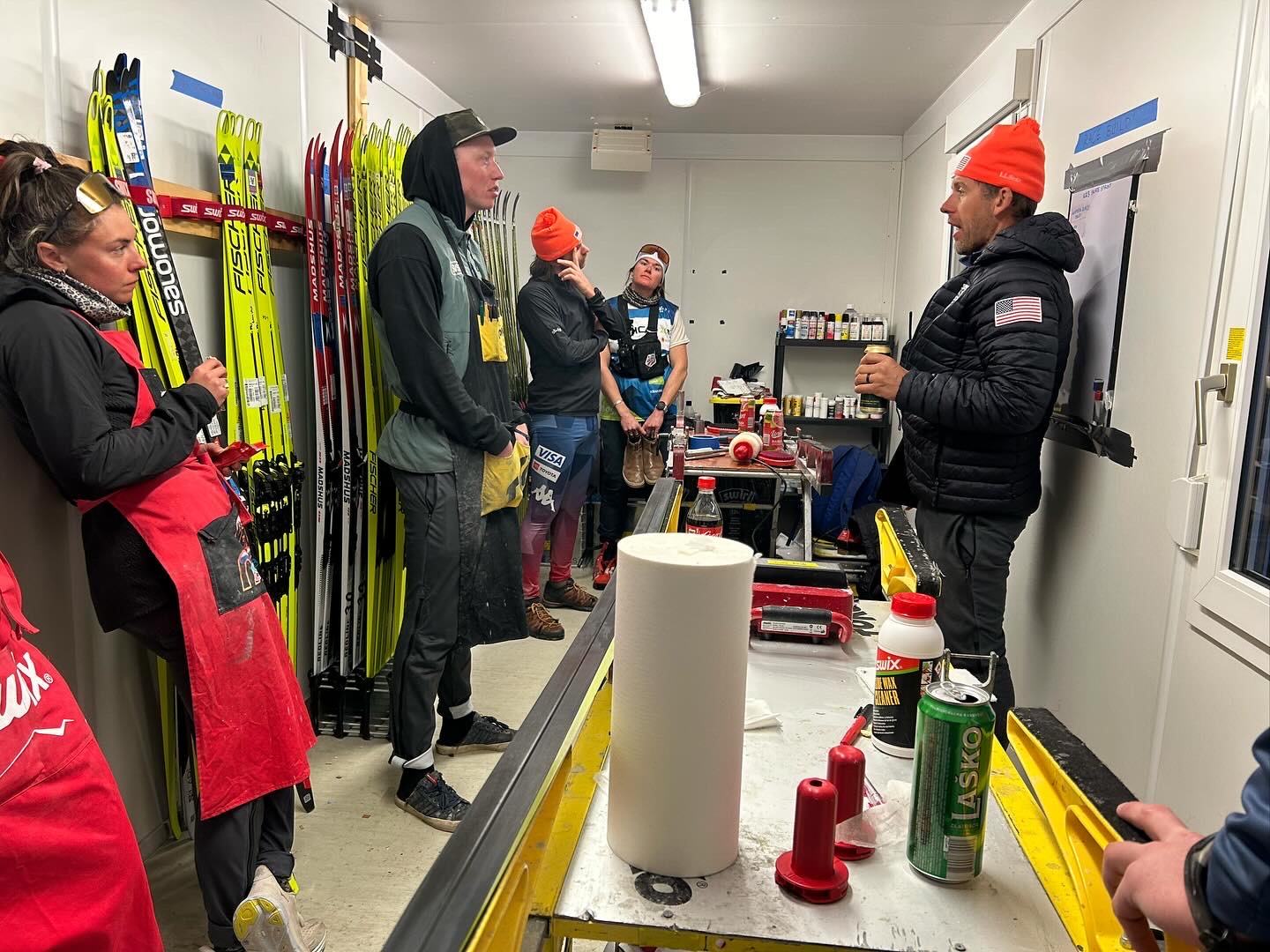
US Team Support Staff
Whereas the athletes have gained familiarity from spending time on course and off course, the US still remains unique in its community-spanning approach to supporting those athletes. Other skiing nations dedicate development team staff down to medical and wax support that work together throughout the season, while the US prefers to gather this staff from across the club system for each championships. With coaches and technicians hailing from places as far removed from each other as Maine, Alaska, and everywhere in between, there’s likely an expert in the cabin for just about any snow condition one might encounter. With support staff coming from more places, and more backgrounds, there’s more ideas in the mix whenever the crazy situations that travel and racing (and they will be crazy) arise. Flexibility is key. The cross-paths between regions and ski communities skiers weave within the US becomes thread into a wholistic tapestry.
That tapestry this year looked like a lot of big “USA” jackets and suits walking around Planica in the past week and a half, as a week-long championships including a skate sprint, followed by a 20 k skate mass start, 10 k classic individual start, and finally a 4×5 k relay saw the juniors and U23s swap race days, and the US work to find success each day.
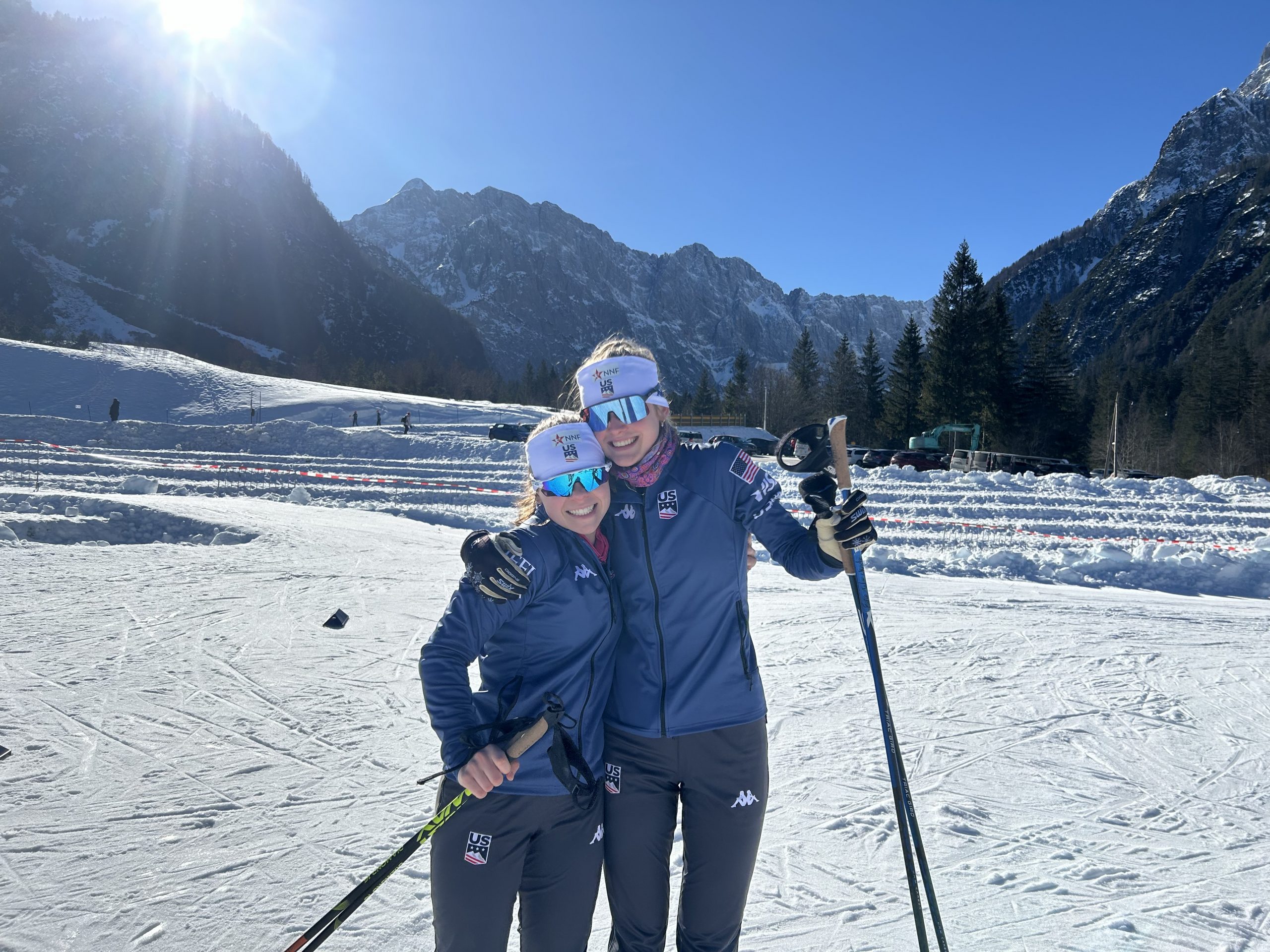
Junior Skate Sprint
The week opened with a Junior skate sprint that also set standards for the kinds of courses racers could expect at Planica. The steep walls of the alpine valley kept conditions firm through the mornings, but when the sun did hit the track, it hit it hard, leading to slush and t-shirt skiing. The Planica course was the same one used for a classic sprint during 2023 World Championships, with a windy, downhill half kilometer opening to a long, winding climb into the stadium.
On a firm course, it was raced fast and close, with a second either way translating to five places gained or lost. Given that, the Americans first run of the week translated to a start that confirmed a strong team from top to bottom, wax techs to coaches to skiers. Ava Thurston (Dartmouth) led a group of four American starters that all made it into the heats, a first at a World Junior Ski Championships for the US in a sprint. Thurston placed second, with Sammy Smith (Sun Valley) in fifth, Evie Walton (Dartmouth) 27th, and Sofia Sirica (Middlebury) 30th all close behind. The Junior boys would see the other side of the close-running Planica course, as top American qualifier Zach Jayne (University of Utah) placed 32nd, less than a second out of the top 30. Second American qualifier Trey Jones (University of Colorado) wasn’t off by much more, finishing in 39th.
A close fought qualifier would give way to even closer heats in the afternoon. Evie Walton would be the first American starter out of quarterfinal 2, where she would find herself poised to take the fast, winding downhill on the Planica course from back in the pack, before looking for room on the long uphill that followed. Walton found space near the top of that hill, but reached it just a little too late, and was only able to move into 5th place in the heat. A similar pattern would see Sofia Scirica and Ava Thurston through out of the fourth quarterfinal, with Thurston nearly able to pull off the move to come back into the stadium, but losing out narrowly in the closest heat the quarterfinals had on offer.
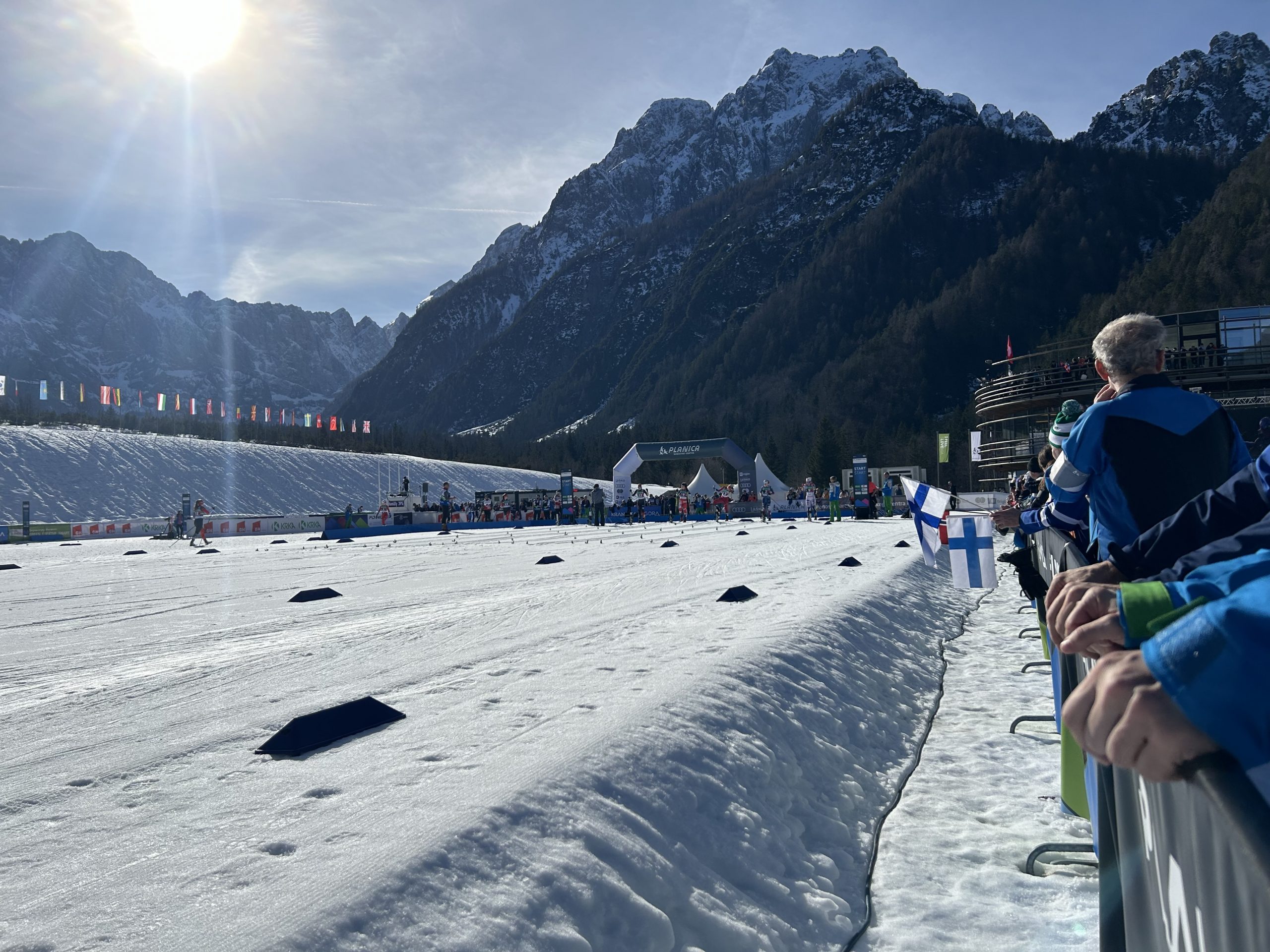
In slight contrast to the other Americans, Sammy Smith started looking to work the first downhill of the course, and in doing so, bring the pack with her. She did so successfully that when her third quarterfinal hit the bottom of the course, a duo of skiers representing Norway and Sweden were able to draft around and start the long climb in front of the American. It was at that point that a principle rule that would follow through the week was established; there’s nothing that quite motivates Sammy Smith like a pack to chase. Smith moved steadily, and then in the climb’s final pitch, decisively. She pulled into the finishing straight in first, and onto the semi-final.
It was in the semi-final where Smith would come up against the top qualifier on the day for the first time, Gina Del Rio, representing the small, Pyrenees-bound nation of Andorra. The duo would make for a compelling, if not, controlled semi-final where Del Rio looked comfortable taking it out, and Smith seemed comfortable knowing she had one skier she had to mark. Again, they went on the final climb, and again, a controlled finish for Smith, off of Del Rio, sent the American to the final.
In the final, Smith would cue off the Andorran again, but this time was joined in a more frantic start by the rest of the field. In the process, she found herself with room to make up to the front as the pack wound into the final climb, but again, found room for herself. By the top of the climb, Smith had worked her way to being right off of Del Rio, alongside Norwegian Milla Grosshaugen Andreassen, and as they wound over the bridge that acted as an entrance to Planica’s final straight, Smith seized the opportunity to at the very least net herself a medal. Del Rio comfortably hit the line in first, but right off her, having gained a clear edge, was Sammy Smith in second place. Andreassen finished in third.
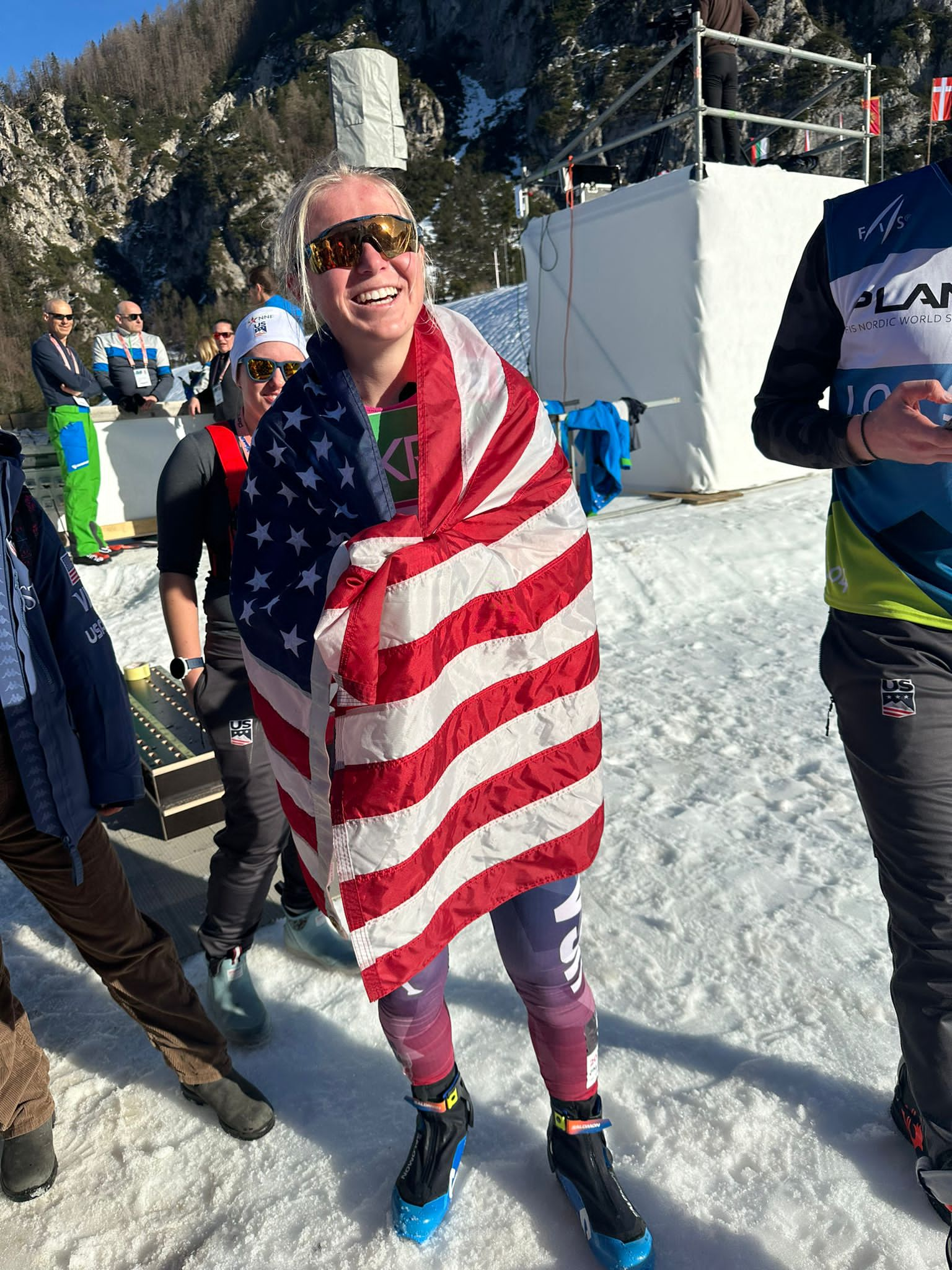
The picture of the post-race was about as perfect as you find in skiing. The sun was starting to cast golden shadows that made the Stars and Stripes that quickly found their way around Smith’s shoulders glimmer a little more. The Boise, Idaho native is the first to admit that this year has been a whirlwind for her – she has danced between SuperTour wins, and World Cup sprint heats – but also that the sprint medal, a World Championships sprint medal, was a clear apex so far. Around the American camp too, it seemed to lift the possibilities for the rest of the week. Everyone who had started the Junior sprint had been in it for the Americans, and with one definitive result, the drive to push for more permeated the mood around the hotel Ristorante dinner tables that night.
U23 Skate Sprint
There was a subdued buzz as day two got underway in Planica the following morning. All the variables around the skate sprint were nearly identical for the U23s, and with the showing from the US juniors the day before, that left a the US team with a glint of confidence going into the qualifier.
That glint translated into another strong performance. Again, the Women went first, and again, every American starter qualified for the heats. Haley Brewster (University of Vermont) led the way, qualifying in fourth, with Anabel Needham (Michigan Tech) qualifying in 15th, and Nina Seeman (Dartmouth) rounding it out in 22nd. The American men would follow suit, with Brian Bushey (University of Utah) leading in third place, John Steel Hagenbuch in sixth, and Walker Hall (University of Utah) in 23rd.
The sun came out for the heats again, which softened the bottom part of the Planica course that remained a fast downhill, then climb to the finish, in its racing dynamic. The Women’s quarterfinals would again see a series of near issues for the Americans, with Haley Brewster simply running out of room to sprint to a second place after a late move in her heat, and Anabel Needham and Nina Seeman both pushing to competitive finishes in their heats as well.
None of the American Women went through to the semi-final then, but the way they raced would play a key factor in informing how their teammates in the Men’s field would race. Having watched from the stadium, Hagenbuch, Bushey and Hall all marked the importance of risking it through the slushy downhill conditions and the trouble they might bring early on in the heat for the reward of staying within the lead pack as they hit the climb. They saw that you didn’t have to be out in front, but that you did need to be in it, in order to give late moves on the climbs a chance.
Bushey and Hall, skiing out of the same fifth quarterfinal heat, employed this strategy to put themselves in a dead heat sprint until the very last. They would wind up with Hall in fourth and Bushey in fifth, with Hall missing out on a lucky loser spot by an agonizingly close margin,
Out of the third quarterfinal heat though, John Steel Hagenbuch had gleaned total confidence in his approach to the course by watching the others. He aptly maneuvered to the fourth position at the bottom of the Planica sprint climb, and then turned the tempo up in a way that the rest of the heat couldn’t match. It yielded him a berth to the semi-final and solidified his approach. “That’s the move,” he said to the US stadium staff after the quarterfinal, and he would look to trust his approach to new heights in the subsequent rounds.
That approach wavered slightly in the semi-final, where Hagenbuch’s final push yielded him a fourth place lucky loser spot into the final, but it didn’t waver his trust in his approach or his strengths as a skier. So, when the final began with Hagenbuch in it, he was poised and back in the pack at first. When the climb came, a surge from a pair of Norwegians, Aleksander Elde Holmboe and Matz William Jenssen, came from the front, but Hagenbuch was already into a move of his own further down. That trust to push on his own terms gave him a jump on the other competitors chasing the Norwegians, and as the course straightened out into a sprint, gave him what he needed to secure his first World Championships medal. Holmboe would take the win, Jenssen the silver, and John Steel Hagenbuch would take bronze to make it back-to-back days on the podium for the United States.
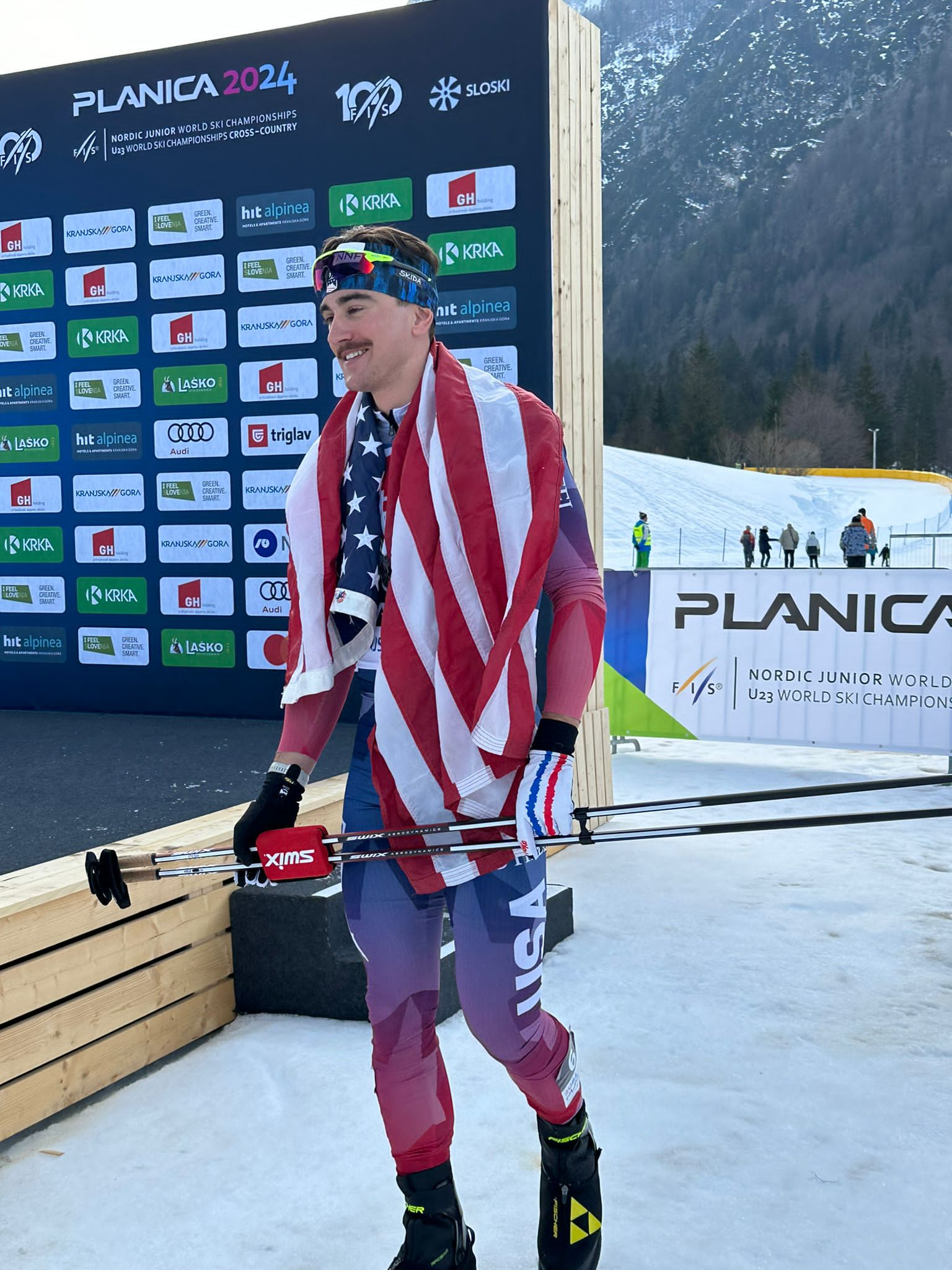
For Hagenbuch, it was a milestone, that came all the sweeter because it was, admittedly, a surprise. The Sun Valley product has already had World Cup success, with a 13th place finish earlier this year in a 10 k skate in Östersund, but his own sense of his abilities on the World stage had been limited to distance racing. To have success in the sprint on such a grand scale served as an achievement in its own right, but his ability to trust himself in knowing how he could, and would, find success throughout the day, seemed to be the more important take-away for later in the week, and beyond.
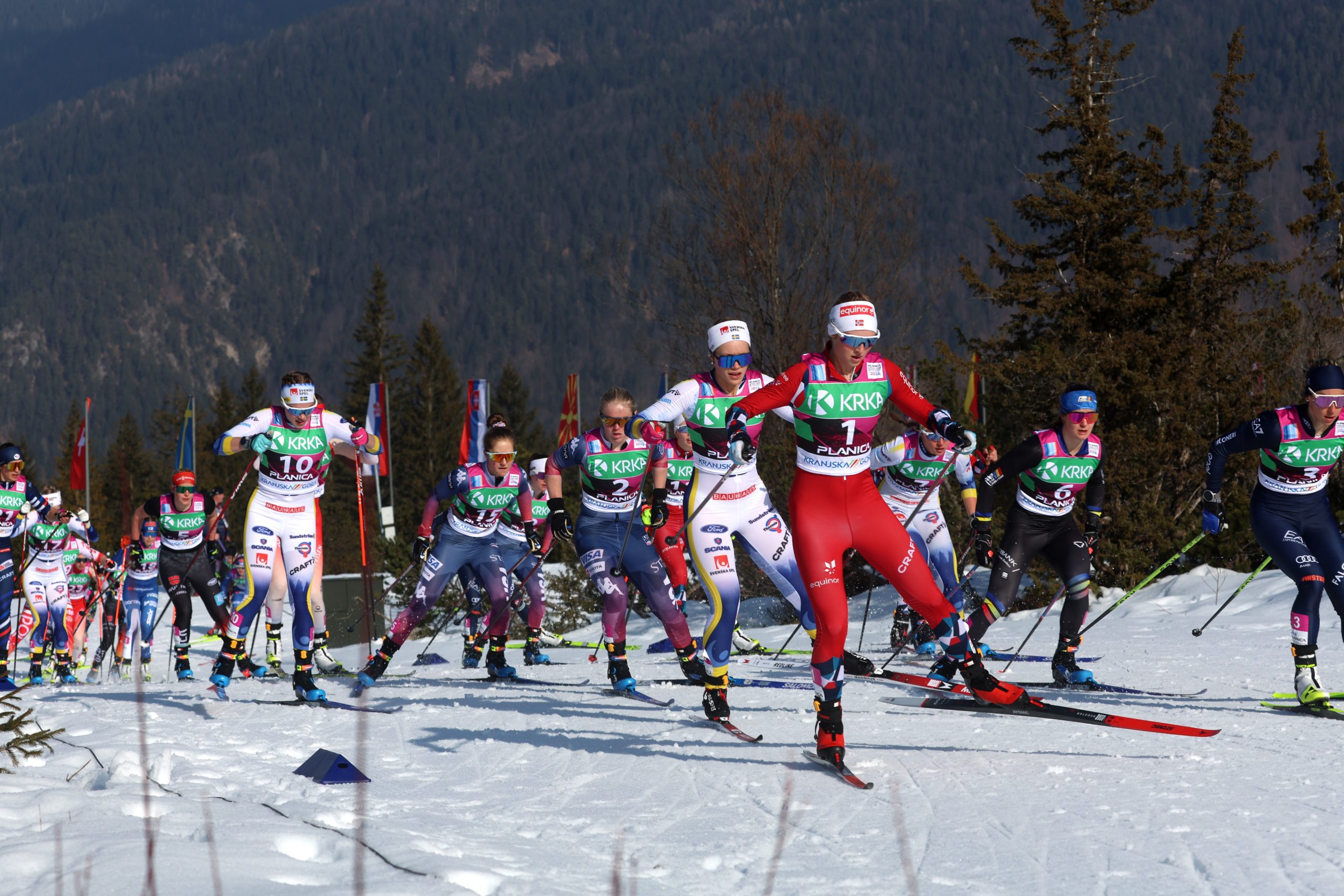
20 k Skate Mass Start Juniors
When the juniors returned to action Wednesday, the skis from Monday hadn’t at all switched out, but how far they would go had. Still stable warm conditions under sunny skies played host to the Junior 20 k, raced on six laps of a 3.3 k course.From the start, the American starters on the day were grouped together, and grouped up front, with Ava Thurston and Sammy Smith returning to action and Nina Schamberger (University of Utah), and Ally Wheeler (High Plains) joining alongside them through the early part of the race.
Through four laps, the pace lifted steadily, but didn’t prove too much to snap the pack. Then, a move from Italian Maria Gismondi started to break the field into groups, and the American starters separated. Ava Thurston held on in the first chase pack for the rest of the race, and would net herself a seventh place finish, the first top ten of her junior World Championships career. Further down, Sammy Smith held fast for a 16th place finish, while Ally Wheeler, in her first World Championship race ever, skied to a 24th place finish. Wheeler also helped Nina Schamberger through a painful second half of the race, as Schamberger fought through back spasms to finish in 27th, but, as is sometimes an impressive result on its own, the result sheet.
The Men’s Junior race that followed in the afternoon was defined by sun-baked slush and a clearer cut dynamic. Through two laps, it was a pack race. Then, as the lead group of thirty headed out on lap three, a switch was flipped by Norwegian Joergen Nordhagen. By the time the 19 year old made what would be the decisive move, his pedigree was already without question. In fact, the 20 k was set to be his last competitive ski race ever, as he is signed on as a member of cycling’s premier Grand Tour-winning team, Jumbo-Visma, starting this spring (where he’ll join Durango, Colorado native Sepp Kuss as a cycling talent with a nordic skiing background).
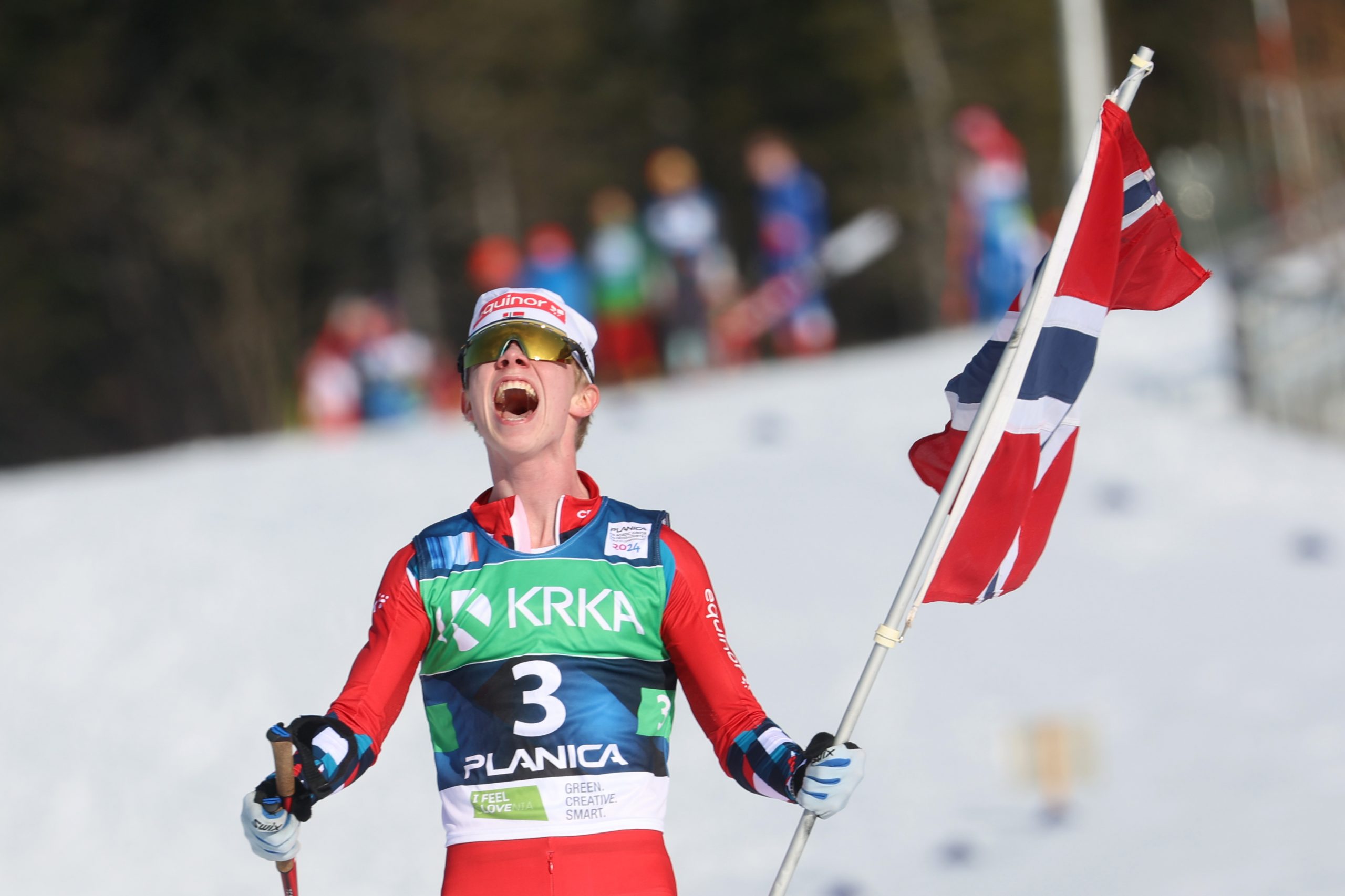
On the six lap course, Nordhagen’s eventual two minute plus winning margin proved devastating. Nearly half the field of starters was pulled off course for being lapped through the second half of the race. Behind him, it also left a tough, strung-out fight for any spot within the top 30. In that mix was Jack Lange (Dartmouth), who survived the initial break of the pack to ski himself into a pack for positions 9-12. The New Hampshire native was merely hanging on to that pack into the last lap before a distinct uptick of pace on every climb the Planica course could offer helped him fight his way to the front. He crossed the line as the top American, in ninth place, and with his first World Championships top ten.
Behind Lange, Zach Jayne would finish the race in 47th, with Wes Campbell (Michigan Tech) finishing in 57th.
U23 20 k Skate Mass Start
Another day in Planica yielded yet another day of sun and cold transformed snow giving way to slush in the afternoon. With three days under the belt, the US team was starting to pin-point the extra variables playing into performance in the Planica conditions, and the starters in the U23 race all played a particularly collaborative role in the journey to the race start—picking skis and race tactics together.

The journey from the start to finish would likewise follow suit. In the Women’s race, Haley Brewster, Novie McCabe (Alaska Pacific University) and Kendall Kramer (University of Alaska-Fairbanks) all remained close in the lead pack through the first half of the race. When the pack stretched, Kramer fought to finish in an eventual 17th place, while Brewster and McCabe eventually moved their way to the front together.
Through lap 5, a loose group of six racers remained with the two Americans in it. Swiss skier Marina Kaelin was prominent up front, with French skier Maelle Veyre in as well. Those two and the American duo managed to gain a slight advantage over chasing skiers Lilliane Gagnon (CAN) and Helen Hoffman (GER), and as they came off of the final downhill in Planica, there was little to be discerned about who would take the win. For the Americans observing though, the pure, exalting shouts to “GO HALEY!, GO NOVIE!” also held an implicit logic, with two skiers in the lead group rather than the Swiss and French one, the odds were much better for the USA. Kaelin would launch the final sprint off of the stadium corner in Planica, and Haley Brewster had the most defiant response. The 20 k skate American national champion in Soldier Hollow last month proved that her efforts were truly world class, as she took World Championship silver, her first World Championship medal and the third in three days to start the week for Team USA.
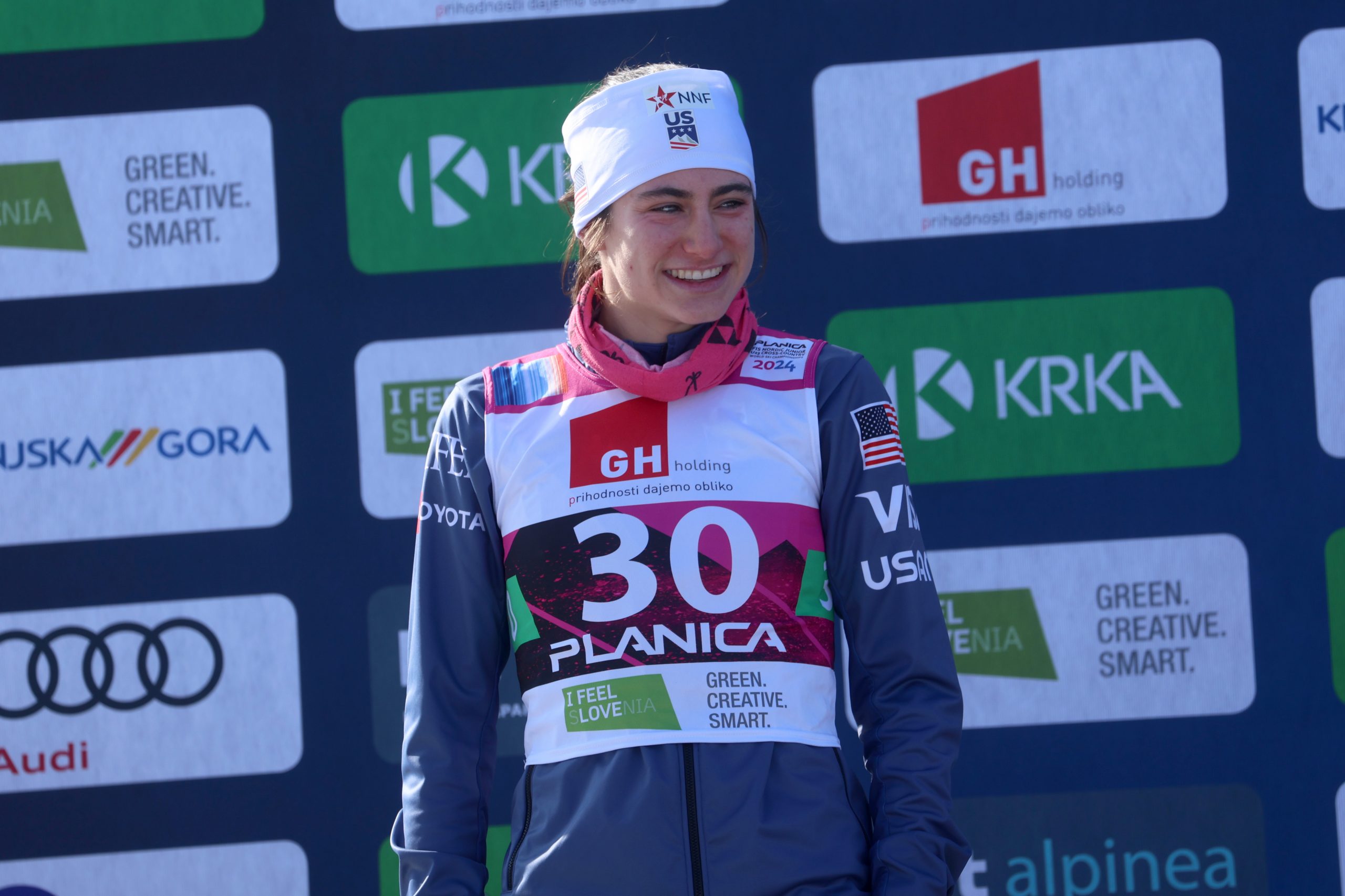
Behind Brewster briefly, Novie McCabe engaged in a close-moving sprint with Veyre, and ended up in fourth place. The momentary disappointment wouldn’t deter McCabe from the realization of her accomplishment, and that of what the USA had just had happen. In the longest, toughest race at World Championships, the Americans had been the most prominent country in the leading pack. The eventual 17th place for Kendall Kramer, and 31st for Anabel Needham, only cemented that the result had shown a new depth for the youngest generation of American women in the distance field at World Championships.
The Men’s race that followed in the afternoon would see the same tight-knit racing from the Americans, as John Steel Hagenbuch, Brian Bushey, Logan Moore (Middlebury) and Elijah Weenig (University of Denver) all found themselves skiing together at one point early on in the race. Through subsequent pace lifts, the Americans stretched out, with John Steel Hagenbuch the eventual leader in 17th place on the day, Brian Bushey in 28th, Logan Moore in 37th, and Elijah Weenig in 39th.
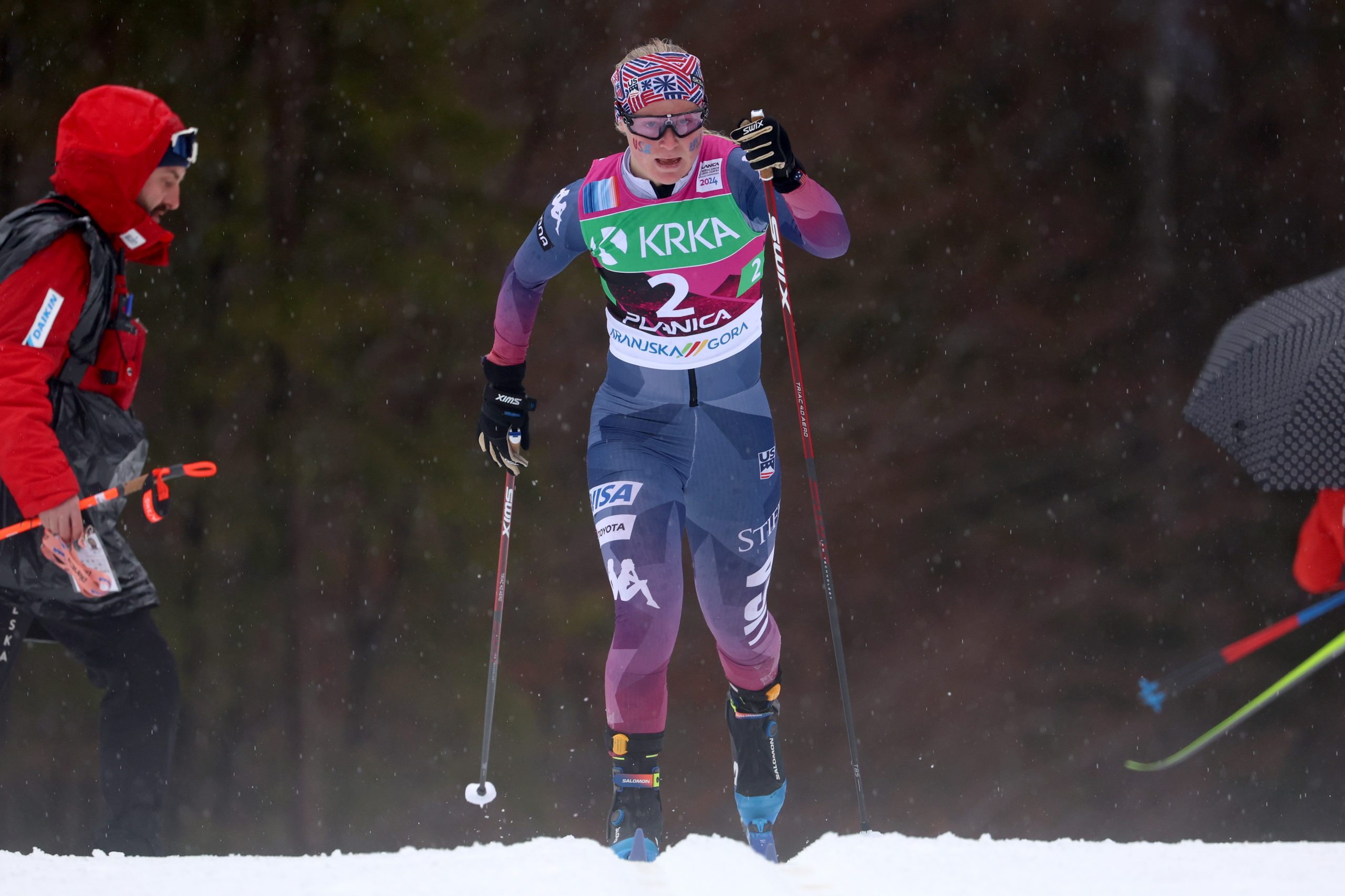
Junior 10 k Classic Individual Start
Then, came the rain. As World Juniors turned to classic skiing for the first time, the conditions in Planica changed dramatically from a spring-like sun to a driving, spring-like rain. Clear klister conditions gave way to conditions in which double-pole skate skis, and zeroes all came into the mix across the field. Planica itself seemed determined to showcase the cerebral, compacting and complex variable demanding side of cross country skiing, and the rest of the week would do just that.
The Junior 10 k would see Sammy Smith showcase her all-roundedness as a skier, as she saw splits in the top ten throughout the course translate to sixth place finish in the Women’s field. Ava Thurston too, demonstrated her balance as a skier, finishing 21st on the day, while Evie Walton skied to 41st place and Nina Schamberger finished in 56th.
The top Men’s performer for the US would again be Jack Lange, who skied to a 20th place finish in the afternoon’s action. Lucas Wilmot (Jackson Hole) finished 55th, with Trey Jones 58th, and Wes Campbell 67th.
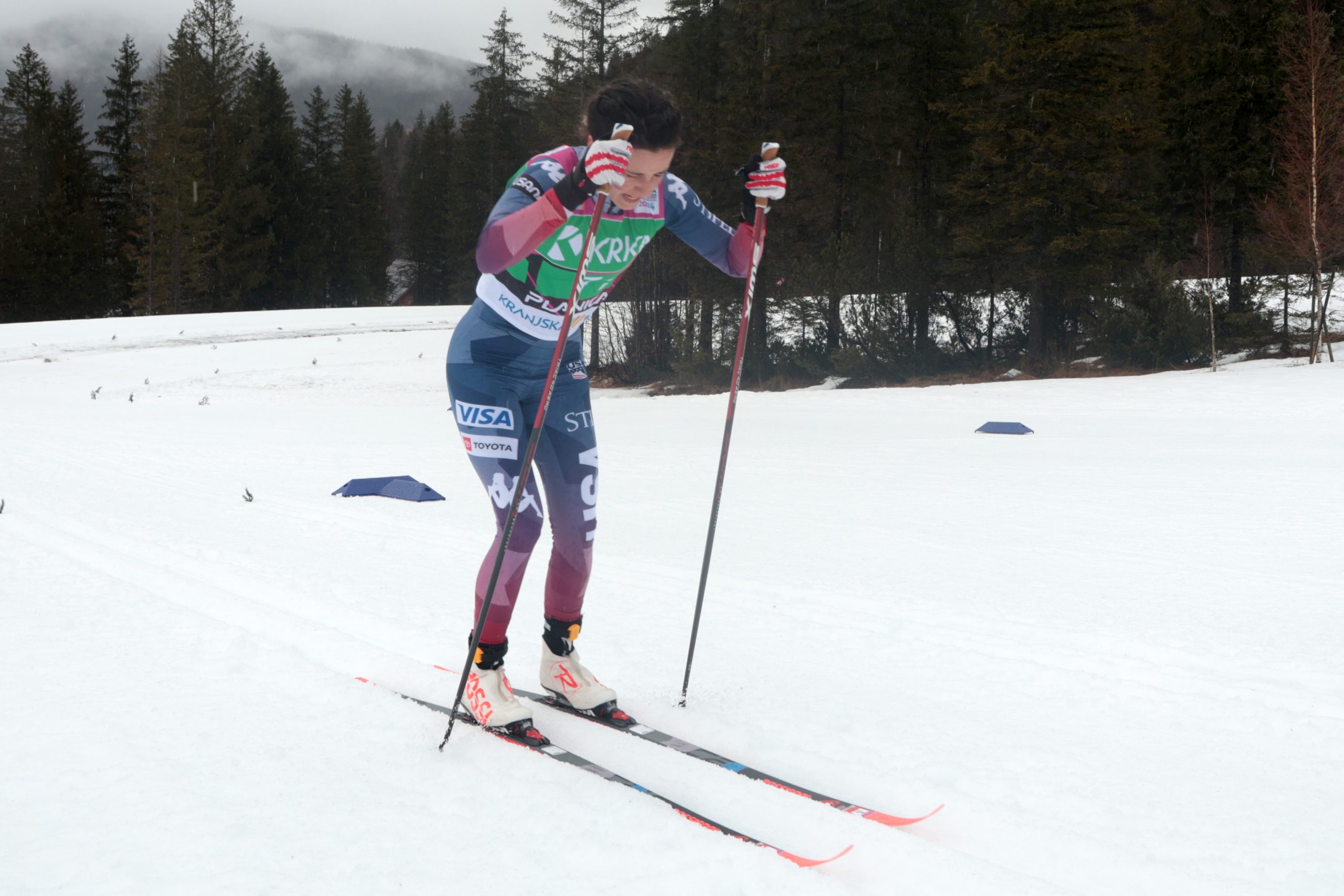
U23 Classic 10 k Individual Start
The following day would see the rain continue to fall, as the U23 field took to the same 10 k course as the juniors had the day prior.
In the Women’s field, top performances again would go to Haley Brewster and Novie McCabe, who finished 12th and 22nd, respectively. Kendall Kramer again turned in a strong performance in 31st place, with Nina Seeman close behind in 34th place.
The top Men’s performer was again John Steel Hagenbuch in 22nd, with Brian Bushey in 37th, with Logan Moore in 52nd rounding out the American results.
The relative elation of the early week was dampened, quite literally by classic results initially, but a close reflection of the US’s standing was quickly put into perspective by what lay ahead. With Team Relays ahead the next day, the depth of the American squad especially came into view, Through the entirety of the week, there was only a single race where the Americans hadn’t had a finisher in the top twenty, and also only a single instance without multiple finishers in the top 30. In the context of American ski history, it had been an exceptional week, among the best ever by medal count, number of top tens, top twenties, and top thirties.
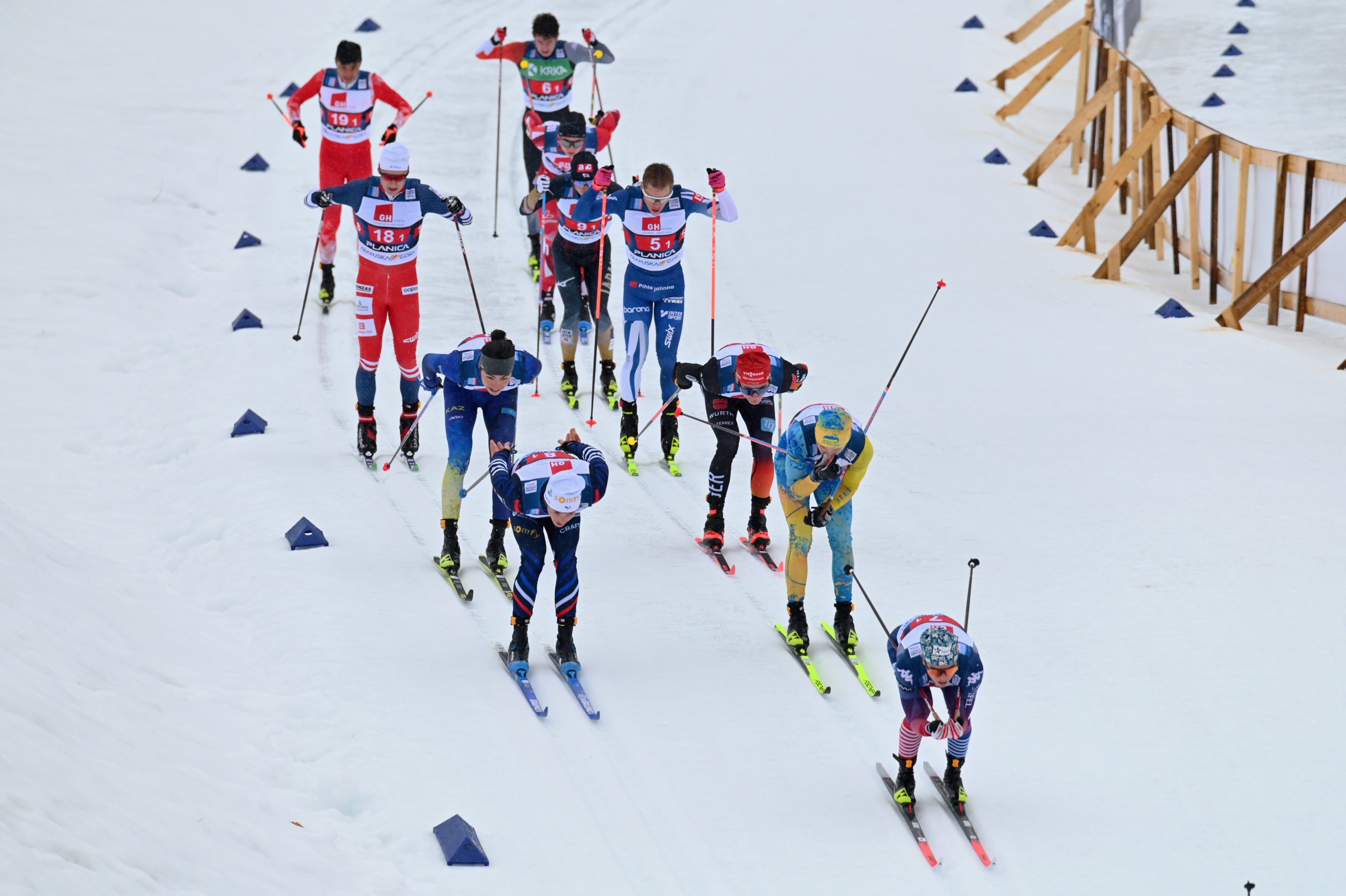
Junior and U23 4×5 k Mixed Relays
At the team meeting Saturday night ahead of the final day of racing, the feelings of the ups and downs of a week of racing floated around in the air for every individual racer and coach. The collective feeling though, was represented by something more solid. As Us Ski Team D-Team Coach Greta Anderson finished briefing the relay team members, Sammy Smith pulled out a special delivery from the World Cup via Jessie Diggins. Relay socks, the original set of red, white, and blue, striped and a little stretched out, came out. Where this iteration of the US relay teams were going, it had the backing of an entire team that had been through the highs and lows of not just a week, but of the journey through the sport that a ski community half a world away had been at for years. That was enough to stir and drive the team into the next day.
The Juniors would go first Sunday, on a course that had started to resemble something like a frozen pond as the rain continued to drive down. The American juniors didn’t seem to deterred, and even pined for some of the more infamous courses they’d grown up skiing in – in the pen before his leg New Englander Jack Lange was heard telling his compatriot from the Italian team that, “this is just like my home!”
The relay was a 4×5 k, mixed in gender and technique. The Men’s classic leg ran first, with Zach Jayne representing the US Team. Jayne stayed steady through an early break in the field, and as things started to stretch, he held fast to a 7th place position that, crucially, left the US Team roughly 30 seconds out of first through the first exchange and in the race.
Jayne handed off to Sammy Smith, and with it, kicked up that principle that had been present with Smith all week: nothing more motivating for Smith than a pack to chase. Through her leg, that’s just what Smith did, turning in a performance that lifted the US into 3rd place alongside the Italian team. Smith’s effort netted her the fastest split on the Women’s classic leg by nearly 15 seconds, and re-invigorated the entirety of the soaked US team that stood by observing the race.
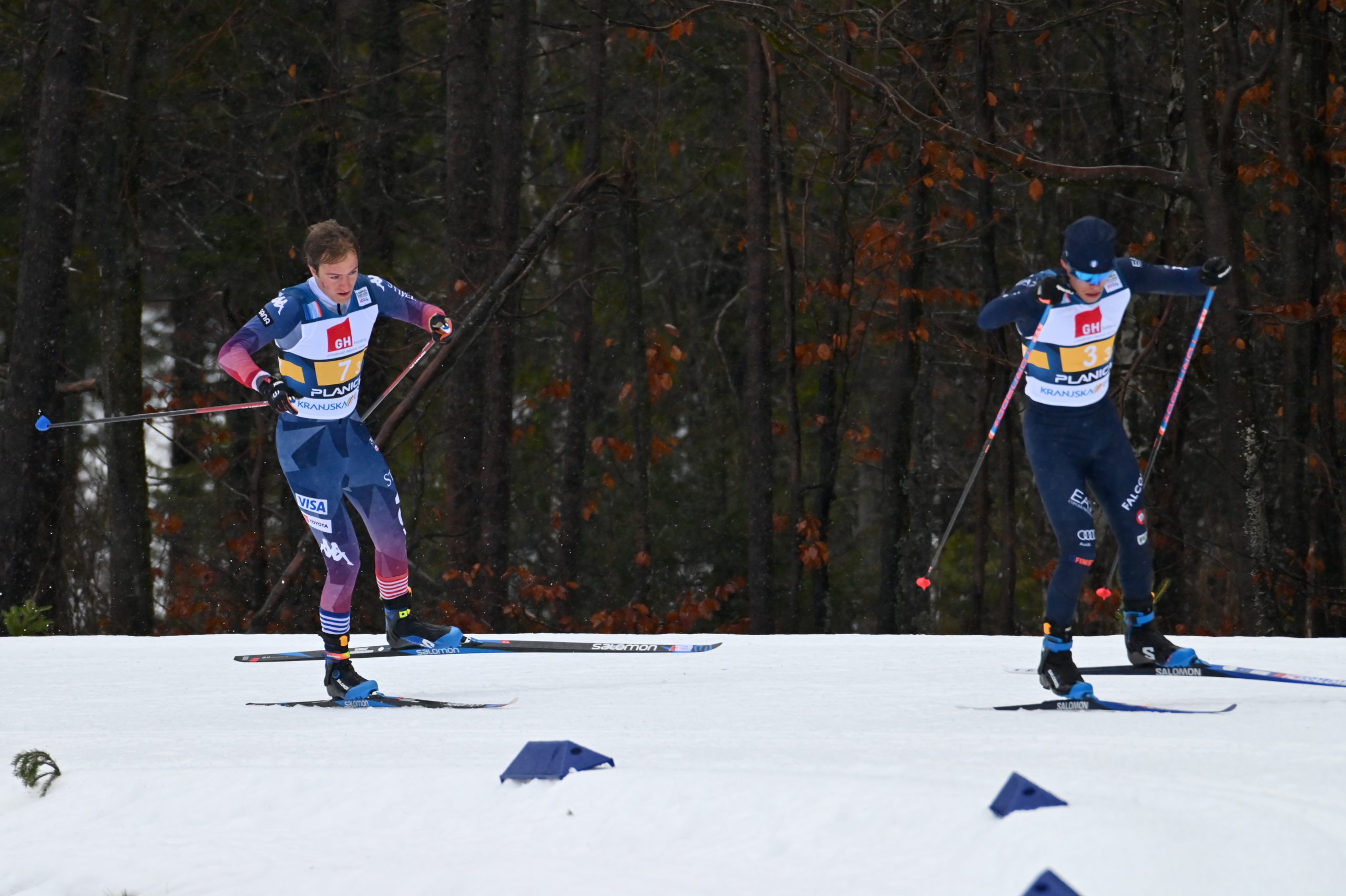
Smith handed off to Jack Lange for the Men’s skate leg, who would be tasked with staying with the Italian team and keeping the chance of a medal alive, as the team’s dueled behind a Norwegian-Swedish battle for gold and silver. As it turned out, Lange’s prognostication that Planica felt a whole lot like home would lead him to ski likewise. Through every surge from the Italian he skied with, Lange reeled back to make it even. When he handed off to his Dartmouth teammate Ava Thurston for the anchor Women’s skate leg, USA and Italy were even.
Thurston would follow Lange’s example through the first part of her leg. She was skiing off of the pace-setting of the 20 k skate champion earlier in the week, Maria Gismondi, with a clear directive to hold on and then use her relative sprint punchiness late to try and secure a medal for the US. On her part, Gismondi kept pressure on early and often, with Thurston able to answer until the final uphill, on the final lap. That’s when Gismondi gained a 15 second gap that would hold for Italy to take third, with Thurston crossing the line in fourth for the Americans.
Again, momentary disappointment gave way to the quick realization that each team member had skied an outstanding leg, and that the US was still a team whose combined powers were greater than the sum of its parts.
That left an auspicious feeling around the U23 team that would start later that afternoon. When the start of that race came, however, the bare reality of ski racing and all its variables came around to bite.

The U23 field started with a Men’s classic race. With the rain piling down on chewed up snow, variability had been added to the once firm deck on the Planica course. Pockets of slow slush accumulated on sheer ice, while some snow spots were now liable to cave to the ground with an ill-planted pole. All of it equated to an extremely messy start for the U23 relay in which American starter Brian Bushey got caught in. Through the first round of pole breaks off the start line, Bushey remained poised, but as the Planica course wound over its first crest, Bushey caught a fellow skier and went down hard. A momentary pause to re-compose himself, a broken pole, and a subsequent ski to the next coach zone for a spare pole left the American team way off a pack that had responded to the early chaos by trying to lift the pace out of trouble.
Bushey would complete his leg, but by the time he handed off to Kendall Kramer for the Women’s classic leg, the US Team was vying to compete for a top 10 position, rather than a medal. Through strong legs by Kramer, John Steel Hagenbuch and Haley Brewster, they would land in 10th place, but it was far off the pack they had wanted to ski with. North America would still wind up with a strong end, as the Canadian team put together a steadfast set of legs to score a win, followed by the French and Swedish teams on the podium.
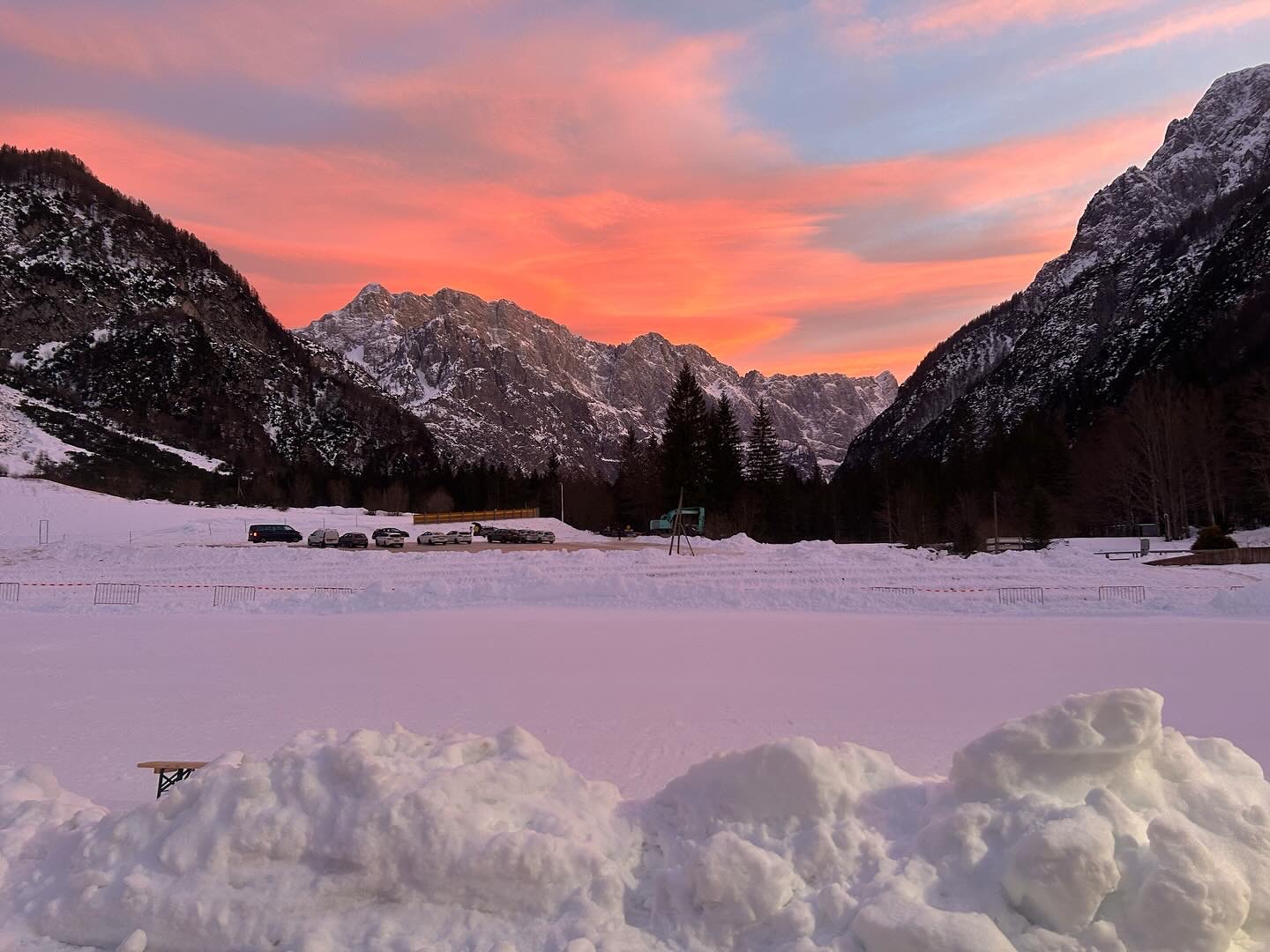
Rain Couldn’t get “U.S.” Down
Any feelings of woe from the unlucky end to the week were lost for the US Team in the rush to pack up and hit the road from Planica after the Relays had wrapped up. There was a long journey home ahead, and uniquely, more firsts to chase on the horizon.
From Planica, more Americans than ever before were taking home medals from a World Junior Ski Championship, and were taking them mostly to one destination: Minneapolis. For some, it would be a return to the World Cup with some dreams accumulated from a lifetime of skiing realized, and more ready to chase. For some, it would be a wholly new thing; a World Cup start, and in an old haunt of American skiing where many just a few years ago in 2021 raced to Junior National Championships.
After leaving the steady, rainy, confines of Planica, the first rays of sunshine that hit the athletes as the United States came back into view on the plane ride home seemed to transform into a metaphor for where the ski community they were all representing was headed. In a World Championships that is designed to spell out the future of the sport, the Americans had nailed it. And now, the future was shining along with the sunshine somewhere over the Midwest, where it will be realized this weekend with an entire ski community on hand to see.
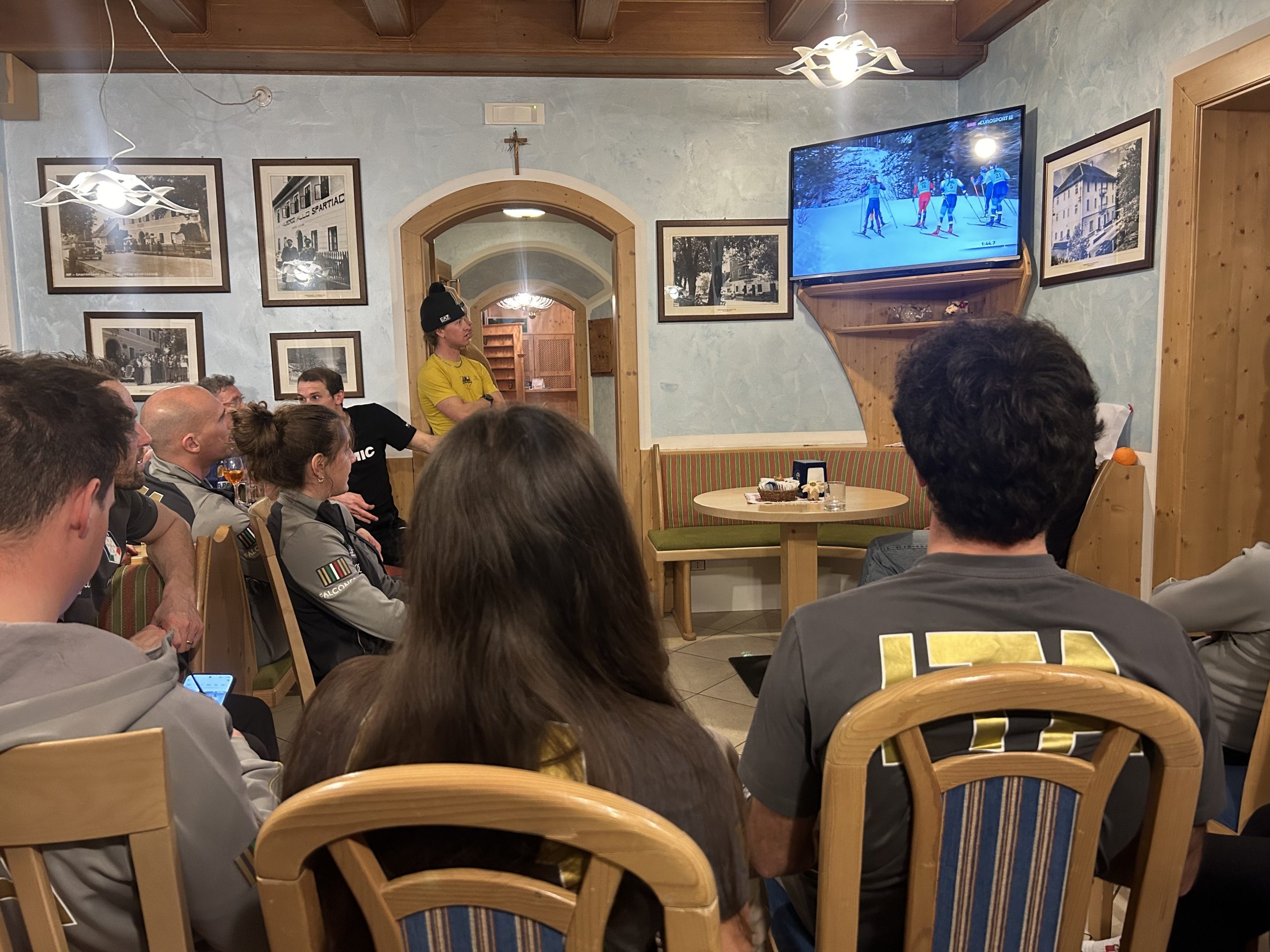
Ben Theyerl
Ben Theyerl was born into a family now three-generations into nordic ski racing in the US. He grew up skiing for Chippewa Valley Nordic in his native Eau Claire, Wisconsin, before spending four years racing for Colby College in Maine. He currently mixes writing and skiing while based out of Crested Butte, CO, where he coaches the best group of high schoolers one could hope to find.



